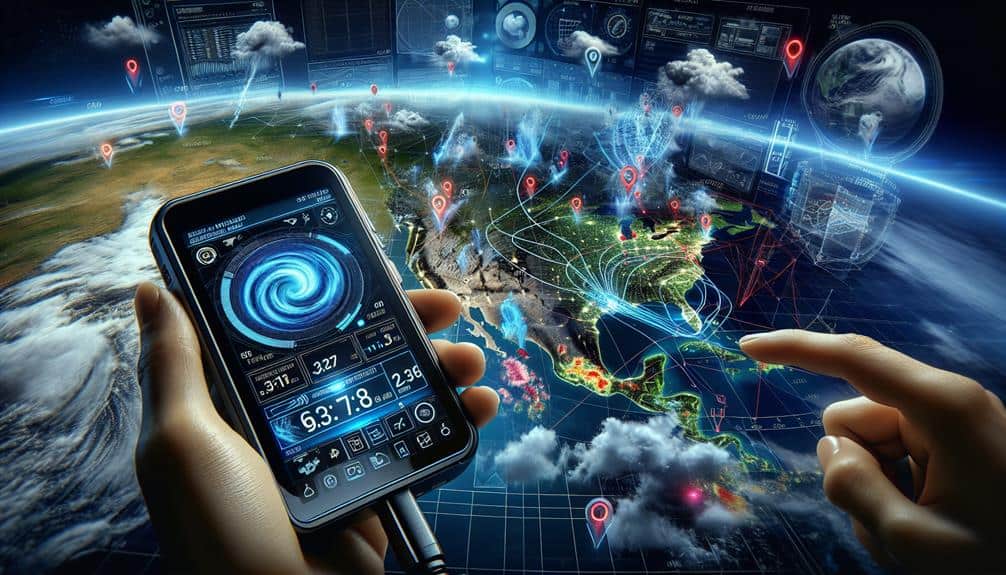We need to track storm trajectories using GPS trackers with robust capabilities for real-time monitoring and precise data. Devices like the Garmin inReach Mini 2 and Spot Gen4 excel in accuracy, leveraging satellite systems like Iridium and GLONASS to guarantee high data integrity and global coverage. These trackers offer mobile app integration, two-way communication, and efficient battery life management, critical for sustained operations during severe weather events. Additionally, their durable casings protect against harsh weather, maintaining reliable functionality. To explore how these features support accurate storm tracking and emergency preparedness, stay engaged with us.
Key Points
- Garmin inReach Mini 2 offers global coverage using Iridium satellite networks for accurate storm trajectory monitoring.
- Spot Gen4 utilizes GPS and GLONASS systems for redundant and precise location tracking of storms.
- Both Garmin inReach Mini 2 and Spot Gen4 provide real-time data access with mobile app integration for remote monitoring.
- These GPS trackers employ advanced algorithms and high-resolution sensors for precise storm trajectory predictions.
Importance of Storm Tracking
Storm tracking is crucial for reducing the impacts of severe weather events on communities and infrastructure. By using precise weather forecasting and emergency preparedness strategies, we can greatly lessen the risk of damage and loss of life. Accurate storm data enables us to predict severe weather, giving us the time to implement disaster response measures that improve community safety.
In the field of emergency preparedness, real-time storm tracking allows us to issue timely warnings and mobilize resources efficiently. For instance, meteorological data collected via GPS trackers can forecast a storm's path and intensity, guiding evacuation plans and strategic deployment of emergency services. Such proactive measures are essential for minimizing the adverse effects of hurricanes, tornadoes, and other severe weather phenomena.
Moreover, thorough storm tracking supports disaster response by providing actionable insights. Data on storm trajectories help emergency teams to optimize their operations, prioritize resource allocation, and guarantee rapid assistance to the most affected areas. This analytical approach not only protects lives but also preserves critical infrastructure.
Ultimately, utilizing advanced storm tracking technology empowers us to safeguard our communities and uphold the freedoms we cherish, even in the face of nature's challenges.
Key Features of GPS Trackers
Given the significant role of storm tracking in emergency preparedness, let's examine the key features of GPS trackers that enhance our ability to monitor storm trajectories accurately.
One of the primary features is extensive satellite coverage. With widespread satellite networks, these trackers guarantee continuous data reception, even in remote or turbulent weather conditions. This allows us to maintain real-time tracking of storm paths.
Signal strength is another vital factor. High signal strength guarantees data integrity and reduces the likelihood of losing valuable information during severe weather events. Advanced GPS trackers often come equipped with enhanced antennas to boost signal reception, which is essential for reliable storm monitoring.
Weather resistance is indispensable for GPS trackers. These devices must withstand extreme conditions like heavy rain, strong winds, and high humidity. Many models are designed with durable casings that offer protection against environmental factors, ensuring uninterrupted functionality during storms.
Data encryption is essential for safeguarding the transmitted data from unauthorized access. Secure encryption protocols ensure that sensitive information about storm trajectories remains protected, providing an additional layer of security and precision.
Top GPS Trackers for Storms
When evaluating top GPS trackers for storms, we must prioritize accuracy and reliability, ensuring data precision under extreme conditions. Real-time data access is essential for making timely decisions, while battery life efficiency determines the tracker's operational longevity during prolonged events.
Let's analyze the leading models based on these critical performance metrics.
Accuracy and Reliability
Evaluating the accuracy and reliability of GPS trackers for storm monitoring, we must consider the latest models that demonstrate exceptional precision in real-time data collection and transmission. Modern GPS trackers like the Garmin inReach Mini 2 and Spot Gen4 offer robust capabilities for data analysis and weather prediction. These devices utilize advanced satellite technology to provide highly accurate location data, essential for predicting storm trajectories with minimal error margins.
The Garmin inReach Mini 2, for instance, employs Iridium satellite networks, offering global coverage and superior dependability. Its precision in data gathering ensures that meteorologists can make accurate weather predictions, thereby enhancing public safety and guaranteeing timely evacuations.
Additionally, the Spot Gen4 leverages GPS and GLONASS systems, ensuring redundancy and improved accuracy, which is crucial during severe weather conditions.
We must focus on the data integrity these devices provide. The reliability of real-time data transmission is paramount for accurate weather prediction, as any delay or inaccuracy could lead to catastrophic consequences. As such, choosing GPS trackers that excel in both accuracy and reliability isn't just a preference but a necessity for effective storm monitoring and response.
Real-Time Data Access
Accessing real-time data is essential for storm monitoring, and top GPS trackers like the Garmin inReach Mini 2 and Spot Gen4 excel in providing immediate, accurate location information. These devices utilize advanced satellite communication systems, ensuring we can track storm trajectories with precision. Real-time data access isn't just about knowing where the storm is now; it's about making informed decisions for emergency response and safety.
To effectively manage storm tracking, these GPS trackers offer robust features:
- Data Visualization: Both the Garmin inReach Mini 2 and Spot Gen4 integrate seamlessly with data visualization platforms. This allows us to see storm paths clearly and make predictions based on real-time updates.
- Mobile App Integration: Each device supports mobile apps that enable remote monitoring. We can access critical data from anywhere, ensuring we're always informed and ready to act.
- Two-Way Communication: In emergencies, these trackers provide two-way messaging, allowing us to coordinate with response teams and share our precise location.
- Weather Reports: They deliver up-to-date weather reports directly to the device or mobile app, keeping us ahead of any sudden changes in storm conditions.
Battery Life Efficiency
Maximizing battery life efficiency in GPS trackers like the Garmin inReach Mini 2 and Spot Gen4 is essential for sustained storm monitoring, especially during prolonged weather events. By focusing on battery optimization, we enhance our capability to make precise storm predictions. Let's explore how these devices achieve superior energy efficiency for efficient weather tracking.
The Garmin inReach Mini 2 employs a robust power-saving mode, extending operational time up to 14 days with 10-minute tracking intervals. This feature is necessary for long-term monitoring without frequent recharges.
On the other hand, the Spot Gen4 offers custom tracking intervals, allowing us to balance battery consumption with the need for real-time data. It can last up to 17 days on a single charge when set to a 60-minute tracking interval.
Both devices utilize advanced GPS chipsets and low-power communication protocols to minimize energy use while maintaining tracking accuracy. This level of energy efficiency is essential for continuous monitoring during extended storm periods.
Additionally, these trackers often incorporate solar charging options, providing an additional layer of battery optimization. By selecting devices with these capabilities, we ensure reliable and uninterrupted storm prediction, empowering us with the freedom to track weather systems accurately.
Real-Time Data Accuracy
When evaluating real-time data accuracy in GPS trackers, we must consider satellite communication reliability, sensor data precision, and update frequency rate.
These factors collectively determine how effectively we can monitor and predict storm trajectories.
Satellite Communication Reliability
Ensuring the dependability of satellite communication is essential for the real-time precision of GPS trackers used in monitoring storm trajectories. When we consider the complexities of storm tracking, the significance of uninterrupted data flow can't be overstated. Satellite communication plays a crucial role in maintaining this flow, especially in emergency response scenarios where timely information can save lives and resources.
To achieve peak reliability, we must focus on several key factors:
- Redundancy: Implementing multiple satellite networks guarantees that if one fails, others can sustain the data stream without interruption.
- Latency: Minimizing the delay between data transmission and reception is vital. Lower latency equates to more timely updates, which are essential during rapidly evolving storm conditions.
- Bandwidth: Adequate bandwidth allows for the transmission of large volumes of data, which is necessary for detailed storm trajectory analysis.
- Signal Integrity: Ensuring that the satellite signals remain strong and uncorrupted by atmospheric conditions guarantees the accuracy of the received data.
Sensor Data Precision
To complement reliable satellite communication, we must prioritize sensor data precision to guarantee real-time accuracy in storm trajectory monitoring. Our focus on sensor technology enables us to capture high-resolution data, which is critical for precise data analysis. Quality sensors embedded in GPS trackers measure variables like wind speed, atmospheric pressure, and humidity with exceptional accuracy. These measurements form the backbone of our storm tracking systems.
We utilize advanced algorithms to process this sensor data, ensuring that the information we receive is both accurate and timely. This precision isn't just about collecting data; it's about transforming raw data into actionable insights that can predict storm paths with minimal error margins. The fidelity of sensor data directly impacts our ability to forecast storm behavior, providing us the freedom to make informed decisions faster.
In the field of storm trajectory monitoring, inaccuracies can lead to catastrophic misjudgments. Thus, our commitment to sensor technology and meticulous data analysis safeguards the reliability of our predictions. By continuously refining our sensors and data processing methods, we enhance the real-time accuracy of our storm tracking systems, ensuring we remain at the forefront of meteorological advancements.
Update Frequency Rate
Our storm tracking system's real-time data accuracy hinges on the update frequency rate of the GPS trackers. When it comes to storm prediction accuracy, the speed at which data is refreshed plays a pivotal role. High update frequency guarantees that we capture the rapid and often unpredictable movements of storm systems with precision.
Let's explore further into how update frequency impacts our system:
- Timeliness: Higher update frequencies provide more timely data, which is crucial for real-time storm monitoring. This can mean the difference between timely warnings and outdated information.
- Resolution: Frequent updates enhance the spatial and temporal resolution of our data, enabling us to pinpoint storm trajectories with greater precision.
- Predictive Models: Accurate and frequent data updates feed into our predictive models, refining our storm prediction accuracy. This helps in forecasting the storm's path and potential impact areas more reliably.
- Resource Allocation: Efficient update frequencies allow for best resource allocation, ensuring that we deploy storm response measures where they're needed most, minimizing risk and maximizing safety.
Integration With Weather Systems

By integrating GPS trackers directly with advanced weather systems, we can enhance the accuracy of storm trajectory predictions through real-time data assimilation. This integration capitalizes on the strengths of both technologies, merging high-resolution positional data from GPS trackers with meteorological models. When we incorporate real-time GPS data into weather forecasting, we achieve more precise and timely updates on storm movements, critical for both public safety and infrastructure management.
Utilizing such integrated systems, emergency response teams can make more informed decisions. With improved storm trajectory predictions, these teams can allocate resources more effectively, plan evacuations with greater precision, and minimize potential damage. The key lies in the seamless flow of data between GPS trackers and weather systems, reducing latency and maximizing response time.
Moreover, this integration supports adaptive forecasting models that adjust dynamically as new GPS data becomes available. This leads to finer granularity in predicting storm paths, which is invaluable for regions prone to sudden weather changes. By harnessing the power of real-time data assimilation, we empower ourselves to act swiftly and decisively, enhancing our collective resilience against natural disasters.
This approach not only elevates our predictive capabilities but also fortifies our emergency preparedness.
Durability and Reliability
Maintaining the durability and reliability of GPS trackers is crucial to sustaining the continuous flow of accurate data for storm trajectory predictions. We must focus on devices that can withstand the harsh conditions they'll inevitably encounter.
Long term performance is critical; a tracker that fails mid-operation can compromise the accuracy of our predictions. Evaluating weather resistance is an essential step in our selection process.
To secure robust performance, we consider the following:
- Material Composition: High-quality, weather-resistant materials such as industrial-grade plastics and corrosion-resistant metals secure the longevity of the device.
- Sealing and Insulation: Proper sealing techniques and insulation shield internal components from moisture, dust, and extreme temperatures, enhancing long term performance.
- Battery Life: Extended battery life guarantees the tracker remains operational throughout prolonged storm conditions without the need for frequent recharges or replacements.
- Shock Resistance: Durability against physical impacts, including strong winds and debris, ensures the device remains functional during severe weather events.
User Experiences and Reviews

Gathering user experiences and reviews provides critical insights into the real-world performance and reliability of GPS trackers under various storm conditions. When we analyze user feedback, we observe a high level of user satisfaction with devices that offer robust product performance. Many users report that trackers with advanced sensor integration and real-time data transmission excel in storm scenarios, providing accurate and timely trajectory information.
A key aspect contributing to positive reviews is the ease of use of these devices. Users consistently praise trackers that feature intuitive interfaces and streamlined setup processes. Such user-friendly designs minimize the learning curve, enabling users to deploy the devices efficiently, even under pressing storm conditions.
Additionally, the efficiency of data analysis plays a significant role in user satisfaction. Trackers that offer sophisticated but accessible data analytics tools allow users to interpret and act on collected data swiftly, enhancing decision-making capabilities in critical situations.
Moreover, the reliability of these devices under adverse weather conditions is frequently highlighted. Users appreciate trackers that maintain signal integrity and provide consistent performance despite challenging environmental factors.
Frequently Asked Questions
How Do GPS Trackers Communicate Data During a Storm?
During a storm, GPS trackers maintain data transmission by employing weather resilience features like robust antennas and signal correction algorithms. We guarantee constant communication, providing real-time data despite adverse conditions, empowering us with reliable information for decision-making.
Can GPS Trackers Predict Storm Intensity Changes?
When storm clouds gather and winds howl, GPS trackers enhance storm prediction accuracy. They monitor atmospheric changes, offering data that improves storm intensity forecasts and impacts emergency response strategies, helping us better prepare and respond effectively.
Are There Any Subscription Fees for GPS Tracking Services?
We've analyzed various GPS tracking services and found that subscription costs vary based on tracking features. Service availability and user preferences also impact pricing. Assessing specific needs is crucial to determine the most cost-effective option.
What Is the Battery Life of GPS Trackers in Harsh Weather?
We've found that some GPS trackers provide up to 20 hours of battery performance in harsh weather. Their durability in storms guarantees consistent tracking, catering to those who value freedom and reliability even in extreme conditions.
How Secure Is the Data Transmitted by GPS Trackers?
We need to address how secure the data transmitted by GPS trackers is. Utilizing data encryption greatly reduces privacy concerns, ensuring our information remains protected from unauthorized access, thereby maintaining our freedom and security in harsh conditions.

